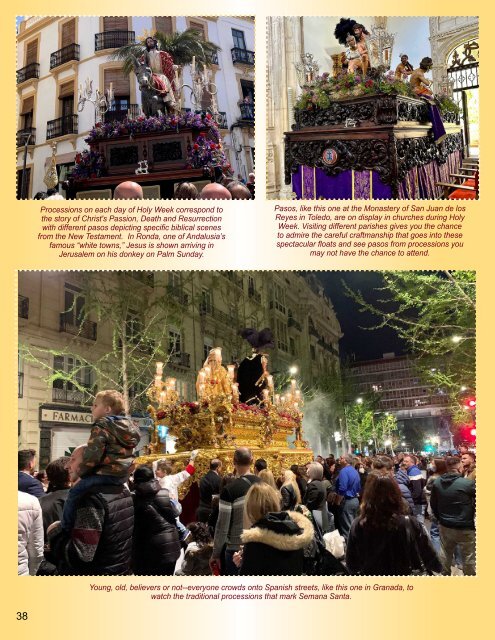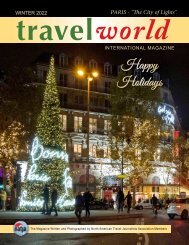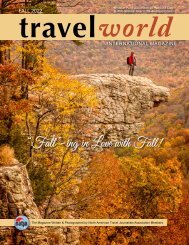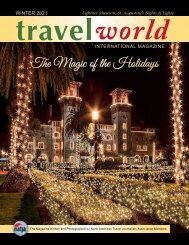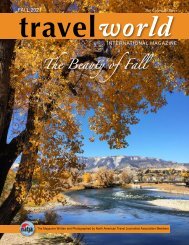*TravelWorld International Magazine Spring 2024
Create successful ePaper yourself
Turn your PDF publications into a flip-book with our unique Google optimized e-Paper software.
Processions on each day of Holy Week correspond to<br />
the story of Christ's Passion, Death and Resurrection<br />
with different pasos depicting specific biblical scenes<br />
from the New Testament. In Ronda, one of Andalusia’s<br />
famous “white towns,” Jesus is shown arriving in<br />
Jerusalem on his donkey on Palm Sunday.<br />
Pasos, like this one at the Monastery of San Juan de los<br />
Reyes in Toledo, are on display in churches during Holy<br />
Week. Visiting different parishes gives you the chance<br />
to admire the careful craftmanship that goes into these<br />
spectacular floats and see pasos from processions you<br />
may not have the chance to attend.<br />
Young, old, believers or not--everyone crowds onto Spanish streets, like this one in Granada, to<br />
watch the traditional processions that mark Semana Santa.<br />
hile the pasos are<br />
being readied, you<br />
can visit them in<br />
their parishes. We<br />
spent days wandering<br />
from church to church in<br />
several cities to see these magnificent<br />
pasos up close, admiring the detail<br />
and careful handiwork of the<br />
cofradias. We had the chance to<br />
chat with one gentleman, Jamie,<br />
who is not only a member of the<br />
brotherhood at the Iglesia de Santa<br />
Maria Magdalene in Sevilla, but also<br />
one of the bearers called 'costaleros',<br />
who carry the massive pasos for up<br />
to six hours through Sevilla’s cobbled<br />
streets. Some, he told us, can weigh<br />
5,000 pounds and take between 35<br />
to 45 men to carry. Only women<br />
carry the Paso of the Holy Mother in<br />
some parishes, as we saw in several<br />
processions in Salamanca last Easter.<br />
Shortly before a procession begins,<br />
the sidewalks and streets swell<br />
with families who seem to appear<br />
from nowhere, and a carnival-like<br />
atmosphere prevails. There are street<br />
vendors selling sweets and snacks,<br />
drinks, balloons, tiny penitent<br />
figures, and other souvenirs. Soon,<br />
the incense smoke thickens, music<br />
starts, and the excitement in the<br />
air is palpable. Fathers hoist their<br />
young children onto their shoulders,<br />
and everyone crowds closer and<br />
often right into the street where the<br />
procession will pass. Some have only<br />
drummers; most have full marching<br />
bands, and sometimes there is<br />
singing. Depending on the size and<br />
importance of the brotherhood,<br />
parish, and the day in Holy Week,<br />
there can be numerous pasos in a<br />
single procession.<br />
Embroidered banners announce the<br />
cofradias and a priest with a silver<br />
cross leads children carrying incense<br />
or lanterns. Nazarenos, in their<br />
Originally, only men could participate in Semana Santa processions as<br />
Nazarenos or penitents. The role of the Mujeres de la Mantilla, or mourners,<br />
made it possible for women to be a part of Holy Week observances in a public<br />
way. They carry candles and rosary beads and always wear all black-- from<br />
their lacey mantillas to their often surprisingly high-heeled shoes.<br />
colored robes, faces covered by capuz<br />
or hoods, and hats called capirotes,<br />
pointing high to the heavens, follow.<br />
These are the penitents. There are<br />
also Mujeres de la Mantilla, ladies<br />
dressed all in black from their<br />
lacey veils to their shoes, silently<br />
processing, carrying candles and<br />
rosary beads. Everywhere in Spain,<br />
men, women, and children march<br />
slowly through the streets during<br />
Semana Santa’s processions, each<br />
with a role to play in this ancient<br />
ritual.<br />
It is magical and emotional to be a<br />
part of this. Many people cry silently<br />
with tears streaming down their<br />
faces, some sob violently, and others<br />
cheer and clap or watch quietly as<br />
the exquisite pasos go by, but you<br />
will not see a blank expression. These<br />
processions touch people at the most<br />
visceral level. Finally, the pasos will<br />
re-enter the church they left hours<br />
before, and the streets empty almost<br />
as quickly as they filled.<br />
Every city we visited during this<br />
sacred time of year had procession<br />
routes and schedules available<br />
online and/or in print. Look for the<br />
booklets in cafes, shops,<br />
and bars. This is valuable<br />
information for visitors<br />
to either find or avoid the<br />
processions. Be aware of<br />
street closures. Whole areas<br />
of a city may be closed to<br />
traffic, and even passing on<br />
foot is extremely difficult,<br />
especially during the most<br />
important processions—<br />
like Good Friday. Sevilla,<br />
Toledo, Malaga, and other<br />
cities have Semana Santa<br />
apps you can download on<br />
your iPhone.<br />
We have been fortunate to<br />
celebrate Semana Santa and<br />
Easter Sunday in Madrid,<br />
Barcelona, Sevilla, Granada,<br />
Toledo, and Salamanca.<br />
Each city offered a unique<br />
and beautiful experience.<br />
No matter which region<br />
you visit, Semana Santa is<br />
an incredible time to be in<br />
Spain.<br />
Holy Week begins on March<br />
24, and Easter Sunday is<br />
March 31, <strong>2024</strong>.<br />
38<br />
39


